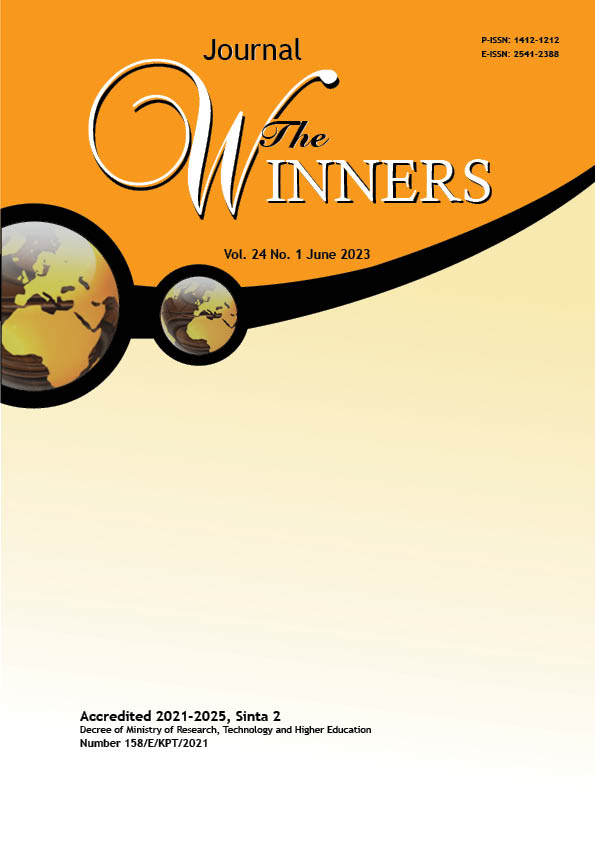The Influence of Market Attractiveness and Unique Capability on Collaboration Strategy and Business Performance: A Study at Digital Creative Industry in Java
DOI:
https://doi.org/10.21512/tw.v24i1.10034Keywords:
market attractiveness, unique capability, collaboration strategy, business performanceAbstract
The creative industry has been a fundamental part of the digital economy, but its profitability remained low, at less than 25% per year. Therefore, the research aimed to ascertain the impact of market attractiveness and unique capabilities on the collaboration strategy, along with their implications for the business performance of Java’s digital creative sector. The population was digital creative industry players in Java Island which focused on the Games, Education, Digital Music, Animation, Software, and Social Media sectors (GEMASS). The sample taken was 50 respondents from the total population as many as 106 legalized digital creative industry players who had been established for more than 3 years. Data were processed using Partial Least Square (PLS-SEM). The findings show that both market attractiveness and unique capability positively and significantly influence collaboration. Market attractiveness has no effect on business performance but has an indirect effect through collaboration strategy. Unique capability positively and significantly affect business performance both directly and indirectly through collaboration strategy. Collaboration strategy positively and significantly affect performance, which is greater than the direct effect of unique capability. Digital creative industry in Java Island are suggested to prioritize the implementation of collaboration strategy that is built with unique capability and consider the market attractiveness.
References
tantangan digital ekonomi di Indonesia. (2017). Invest Indonesia. https://investindonesia.go.id/id/artikel-investasi/detail/5-tantangan-digital-ekonomi-di-indonesia.
Agustiana, F., & Budiastuti, D. (2020). The influence of dynamic capability and collaboration strategy on the company positional advantage (A study of airports in Indonesia). International Journal of Advanced Science and Technology, 29(6), 1226-1234.
Bitzer, V., Glasbergen, P., & Arts, B. (2013). Exploring the potential of intersectoral partnerships to improve the position of farmers in global agrifood chains: Findings from the coffee sector in Peru. Agriculture and Human Values, 30(1), 5-20. https://doi.org/10.1007/s10460-012-9372-z.
Brinker, A. R., Liao, J. L., Kraus, K. R., Young, J., Sandelski, M., Mikesell, C., …, & Loder, R. T. (2018). Bibliometric analysis of gender authorship trends and collaboration dynamics over 30 years of spine 1985 to 2015. Spine, 43(14), E849-E854. https://doi.org/10.1097/BRS.0000000000002562.
Cheglov, V. P., Panasenko, S. V., Shishkin, A. V., Krasil’nikova, E. A., & Maslova, A. E. (2021). Intangible Assets of a Trade Organization in the Context of Digital Transformation. Webology, 18(Special Issue), 1170-1186. https://doi.org/10.14704/WEB/V18SI04/WEB18190.
Cheong, C., & Hoang, H. V. (2021). Macroeconomic factors or firm-specific factors? An examination of the impact on corporate profitability before, during and after the global financial crisis. Cogent Economics and Finance, 9(1). https://doi.org/10.1080/23322039.2021.1959703.
Chin, W., Cheah, J.-H., Liu, Y., Ting, H., Lim, X.-J., & Cha, T. H. (2020). Demystifying the role of causal- predictive modeling using partial least squares structural equation modeling in information systems research. Industrial Management & Data Systems, 120(12), 2161-2209. https://doi.org/10.1108/IMDS-10-2019-0529.
Edeh, E., Lo, W. -J., & Khojasteh, J. (2023). Review of Partial Least Squares Structural Equation Modeling (PLS-SEM) using R: A Workbook. Structural Equation Modeling: A Multidisciplinary Journal, 30(1), 165-167. https://doi.org/10.1080/10705511.2022.2108813.
Fafurida, Karsinah, & Bowo, P. A. (2022). Scale-up collaboration model of village-owned enterprises for increasing village economy. International Journal of Sustainable Development and Planning, 17(8), 2615-2619. https://doi.org/10.18280/ijsdp.170830.
Gepner, P., Tien, N. H., Thi, M., Dao, H., & Minh, D. T. (2022). Analysis of business strategy of leading Vietnamese real estate developers using SWOT matrix analysis of business strategy of leading Vietnamese real estate developers using SWOT matrix. International Journal of Multidisciplinary Research and Growth Evaluation, 3(1), 181-187.
Gunarto, M., Armanto, R., Verawaty, & Achmadi, J. (2021). The role of collaboration in mediating distinctive capability on performance in the digital industry in Indonesia. Proceedings of the International Conference on Industrial Engineering and Operations Management, May, 3028-3036.
Halim, M. A. S. A., Omar, K., Saputra, J., Kamaruddin, S. N. A. A., & Razali, M. K. A. M. (2021). Examining the relationship between entrepreneurship development programs and business performance among entrepreneurs in Tioman Island, Malaysia. Journal of Environmental Management and Tourism, 12(3), 845. https://doi.org/10.14505//jemt.v12.3(51).24.
Haryanto, A. T. (2023, May 23). Startup RI yang punya daya saing tidak hanya di Pulau Jawa saja kok. detikInet. https://inet.detik.com/telecommunication/d-6732256/startup-ri-yang-punya-daya-saing-tidak-hanya-di-pulau-jawa-saja-kok.
Henseler, J., Ringle, C. M., & Sarstedt, M. (2015). A new criterion for assessing discriminant validity in variance-based structural equation modeling. Journal of the Academy of Marketing Science, 43(1), 115-135. https://doi.org/10.1007/s11747-014-0403-8.
Hidayat, S., Setiawan, M., Rohman, F., & Hussein, A. S. (2023). Reawakening digital innovation and collaboration strategy: Strategies to Improve business performance. WSEAS Transactions on Business and Economics, 20, 342-351. https://doi.org/10.37394/23207.2023.20.32.
Hindi, T. N., & Frenkel, A. (2022). The contribution of collaboration to the development of sustainable innovation in high-tech companies. Journal of Innovation and Entrepreneurship, 11(1). https://doi.org/10.1186/s13731-022-00259-8.
Khazaei, M. (2021). Relationship of profitability of world’s top companies with entrepreneurship, competitiveness, and business environment indicators. Applied Economics, 53(23), 2584-2597. https://doi.org/10.1080/00036846.2020.1859455.
Kim, D., & Jin, S. (2022). Innovation capabilities and business performance in the smart farm sector of South Korea. Journal of Open Innovation: Technology, Market, and Complexity, 8(4). https://doi.org/10.3390/joitmc8040204.
Kirono, I., Armanu, A., Hadiwidjojo, D., & Solimun, S. (2019). Logistics performance collaboration strategy and information sharing with logistics capability as mediator variable (study in Gafeksi East Java Indonesia). International Journal of Quality and Reliability Management, 36(8), 1301-1317. https://doi.org/10.1108/IJQRM-11-2017-0246.
Kock, N. (2015). Common method bias in PLS-SEM: A full collinearity assessment approach. International Journal of E-Collaboration, 11(4), 1-10. https://doi.org/10.4018/ijec.2015100101.
Kristinae, V., Sambung, R., Meitiana, Mering, L., Dwiatmadja, C., & Tunjang, H. (2023). Application of RBV theory in entrepreneurial orientation, dynamic capability and customer relationship management. Uncertain Supply Chain Management, 11(2), 707-712. https://doi.org/10.5267/j.uscm.2023.1.010.
Li, G. (2022). Research on the relationships between knowledge-based dynamic capabilities, organizational agility, and firm performance. Journal of Risk and Financial Management, 15(12), 606. https://doi.org/10.3390/jrfm15120606.
Majid, S. A., Ricardianto, P., Pahala, Y., Saribanon, E., Sidjabat, S., Hernawan, M. A., …, & Suryawan, R. F. (2022). Determining optimal marketing based on market attraction and market based strategies by considering customer life time network value. Industrial Engineering and Management Systems, 21(2), 401-408. https://doi.org/10.7232/iems.2022.21.2.401.
Ministry of National Development Planning. (2022). Buku rencana induk pengembangan industri digital Indonesia 2023-2045 (Issue 2).
Nazir, A., Azam, M., & Khalid, M. U. (2021). Debt financing and firm performance: empirical evidence from the Pakistan Stock Exchange. Asian Journal of Accounting Research, 6(3), 324-334. https://doi.org/10.1108/AJAR-03-2019-0019.
Nurhanisah, Y. (2020). Startup Indonesia: Skala usaha dan masalah yang dihadapi. Indonesia Baik. https://indonesiabaik.id/infografis/startup-indonesia-skala-usaha-dan-masalah-yang-dihadapi.
Pamoengkas, I., & Nidar, S. R. (2020). The effect of market attractiveness and value creation on the performance of fertilizer companies in Indonesia. International Journal of Innovation, Creativity and Change, 13(4), 918-931. https://doi.org/10.5220/0009311105230530.
Pesanello, P. F., Thomas, G. D., & Mason, S. (2010). Market access, are you really ready. Journal of Medical Marketing, 10(1), 25-35. https://doi.org/10.1057/jmm.2009.53.
Peshkov, A. V. (2020). Smart technologies as a type of intangible assets of a construction organization and mechanisms for their implementation. IOP Conference Series: Materials Science and Engineering, 880(1). https://doi.org/10.1088/1757-899X/880/1/012081.
Rehman, S. U., Elrehail, H., Nair, K., Bhatti, A, & Taamneh, A. M. (2023). MCS package and entrepreneurial competency influence on business performance : The moderating role of business strategy. European Journal of Management and Business Economics, 32(1), 1-23. https://doi.org/10.1108/EJMBE-04-2020-0088.
Sasmito, T., Nugroho, M., & Ridwan, M. S. (2023). The impact of organizational capability, external networking, entrepreneurism, competitive advantage, and corporate social responsibility (CSR) on performance. Uncertain Supply Chain Management, 11(2), 833-842. https://doi.org/10.5267/j.uscm.2022.12.007.
Sharma, A., Pathak, S., Borah, S. B., & Adhikary, A. (2022). Collaboration strategies in buyer-supplier relational (BSR) networks and sustainable firm performance: A trade-off story. International Journal of Production Economics, 253, 2023. https://doi.org/10.1016/j.ijpe.2022.108558.
Soal pemerataan yang masih jadi permasalahan Startup di Indonesia. (2021). Startup Studio Indonesia. https://startupstudio.id/permasalahan-startup-indonesia/
Spitsin, V., Vukovic, D., Mikhalchuk, A., Spitsina, L., & Novoseltseva, D. (2022). High-tech gazelle firms at various stages of evolution: Performance and distinctive features. Journal of Economic Studies, 50(4), 674-695. https://doi.org/10.1108/JES-12-2021-0644.
Steiber, A., & Alänge, S. (2020). Corporate-startup collaboration: Effects on large firms’ business transformation. European Journal of Innovation Management, 24(2), 235-257. https://doi.org/10.1108/EJIM-10-2019-0312.
Suharto. (2023). Supply chain ambidexterity, business performance and mediating role of lean and agile supply chain strategies. Uncertain Supply Chain Management, 11(2), 557-564. https://doi.org/10.5267/j.uscm.2023.2.009.
Teece, D. J. (2020). Hand in glove: Open innovation and the dynamic capabilities framework. Strategic Management Review, 1(2), 233-253. https://doi.org/10.1561/111.00000010.
Tenenhaus, M., Amato, S., & Vinzi, V. E. (2004). A global goodness of fit index for A or PLS structural. Proceedings of the XLII SIS Scientific Meeting, 1, 739-742.
Thompson, A. A., Peteraf, M. A., Gamble, J. E., & Strickland III, A. J. (2022). Crafting & executing strategy: Concepts and cases (23rd Ed.). McGraw Hill.
Uno, S. S., Supratikno, H., Ugut, G. S. S., Bernarto, I., Antonio, F., & Hasbullah, Y. (2021). The effects of entrepreneurial values and entrepreneurial orientation, with environmental dynamism and resource availability as moderating variables, on the financial performance and its impacts on firms’ future intention: Empirical evidences from Indones. Management Science Letters, 11, 1537-1548. https://doi.org/10.5267/j.msl.2020.12.019.
Urbsiene, L., Monkeviciute, R., & Navikaite, U. (2014). Analysis of the attractiveness and competitiveness of the securities market. Ekonomika, 93(3), 116-140. http://dx.doi.org/10.15388/Ekon.2014.0.3880.
Vukovic, D. B., Spitsina, L., Gribanova, E., Spitsin, V., & Lyzin, I. (2023). Predicting the performance of retail market firms: Regression and machine learning methods. Mathematics, 11(8). https://doi.org/10.3390/math11081916.
Walker, O., & Mullins, J. (2014). Marketing strategy: A decision-focused approach (8th Ed.). McGraw Hill. https://doi.org/10.4324/9780203460054_chapter_1.
Wang, G., Dou, W., Zhu, W., & Zhou, N. (2015). The effects of firm capabilities on external collaboration and performance: The moderating role of market turbulence. Journal of Business Research, 68(9), 1928-1936. https://doi.org/10.1016/j.jbusres.2015.01.002.
Downloads
Published
How to Cite
Issue
Section
License
Copyright (c) 2023 Jimmy Lizardo, Fredella Colline

This work is licensed under a Creative Commons Attribution-ShareAlike 4.0 International License.
Authors who publish with this journal agree to the following terms:
a. Authors retain copyright and grant the journal right of first publication with the work simultaneously licensed under a Creative Commons Attribution License - Share Alike that allows others to share the work with an acknowledgment of the work's authorship and initial publication in this journal.
b. Authors are able to enter into separate, additional contractual arrangements for the non-exclusive distribution of the journal's published version of the work (e.g., post it to an institutional repository or publish it in a book), with an acknowledgment of its initial publication in this journal.
c. Authors are permitted and encouraged to post their work online (e.g., in institutional repositories or on their website) prior to and during the submission process, as it can lead to productive exchanges, as well as earlier and greater citation of published work.
USER RIGHTS
All articles published Open Access will be immediately and permanently free for everyone to read and download. We are continuously working with our author communities to select the best choice of license options, currently being defined for this journal as follows: Creative Commons Attribution-Share Alike (CC BY-SA)

















